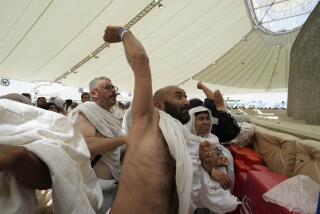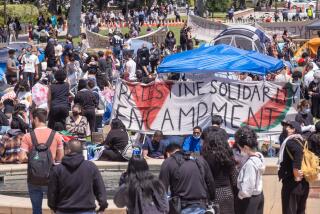Culture : Festival of Miracles Transcends Mideast Enmities : All three major faiths celebrate saints in a pulsating, ancient spectacle of dancing and chanting.
- Share via
CAIRO — It was 1,312 years ago that Hussein, the grandson of the prophet Mohammed, rode from Mecca to Karbala to wrest control of the land of Islam from the usurping hand of the Damascene politicians, only to be slaughtered with his band of 72 warriors by a force of 4,000 men waiting on Karbala’s desolate plain.
Hussein’s head was carried to Kufa, the capital of southern Iraq, where the caliph’s governor slashed it with his cane. “Alas,” said an old man in the silence that ensued, “that I should have lived to see this day--I who saw those lips kissed by the prophet of God.”
Now, in an annual ritual that is part of one of the largest religious festivals in the Middle East, a head said to be that of the martyred Hussein is lovingly reclothed near the end of the Muslim month of Rabieh. As hundreds of thousands of pilgrims gather in the streets outside, it is placed in a shrine that lies at the heart of the most sacred mosque in all of Egypt--Cairo’s Mosque of al-Hussein.
This is the moulid of Hussein.
There is perhaps no other cultural institution so uniquely embedded in the cities and villages of Egypt, North Africa, Syria and Iran as the moulid, a celebration of the life and death of the saints that transcends religious and sectarian boundaries in this troubled region of holy wars--and probably transcends time itself, harking back to the ancient festivals that celebrated the birth of the pharoahs and the flooding of the Nile.
There are Christian moulids in Egypt, and a single remaining Jewish moulid-- the festival of Abu Khatzeira at Damanhour, in which security guards often outnumber the pilgrims from Israel, France and Morocco.
In its classical Islamic form, the moulid is a dizzying spectacle of lighted minarets, whirling dervishes, Koranic chanting, braying animals being led to the slaughter, feasting, the pulsating rhythm of flutes and tambourines, hypnotists levitating the faithful, coal swallowers, tents of home-baked sweets, an occasional circumcision booth and, everywhere, the spectacle of writhing mystics made ecstatic with the contemplation of God.
“Some people get shish kabob sticks and they take them through one cheek and they come out the other, and they are woundless,” insisted Khalid Ahmed Halawein, one of countless Egyptians who makes his living by traveling and selling trinkets at the hundreds of moulids that festoon Egypt’s nights throughout the year. “You can come tonight,” he said. “Maybe they will be here.”
Late last month, an estimated 70,000 Egyptians filled the streets around the Mosque of al-Hussein for the Layla al-Kebira, or “big night” finale of the weeklong moulid commemorated nearly since the dawn of Islam. The crowd, which has in the past been estimated at 1 million for the festival, was down this year following the disastrous earthquake that struck Cairo just before the moulid.
Long strings of red, green and golden lights wrapped the towering minaret of the mosque. Open hospitality tents hosted by the venerable Al-Azhar University, the Ministry of Religious Endowments, and various of Egypt’s 68 Sufi orders--the mystical Islamic sects that are the primary celebrants of the moulids --blared music and religious messages on competing loudspeakers around the building’s perimeter.
Impossibly packed crowds of young Muslim men and women pushed through the streets in what is widely regarded, along with Cairo’s crowded buses, as one of the rigorously conservative city’s principal sexual free-for-alls: No veiled young woman is safe from the groping of her erstwhile manly protectors in these crowds singing Allah’s praises.
For a moulid like that of Hussein, or for the famous moulid of the prophet’s daughter Sayedda Zaynab, thousands of fellaheen , the Egyptian peasantry, trail in from villages around the country, usually caravaning with neighbors from the same village.
“We are more than 20,000 from Luxor, maybe more, all followers of Abul Hagag,” said Hamdi Fikri Mohammed Taha, referring to the upper Egyptian holy man whose mosque lies in the center of the Pharaonic Luxor Temple. “We brought trucks of seven young bulls and 70 lambs, all donations from our neighborhood. Here, we will slaughter them and cook them and eat them. Close or far away, anyone who is hungry eats.”
Miracles and stories of miracles are the spice from which moulids take their power, and there is seldom a shortage of accounts.
At the moulid of the holy man Abul Eila, celebrated in October two days after Hussein, the wall to the holy man’s coffin contained a photograph of a grove of trees in Germany whose trunks grew to form the Arabic words of the Muslim’s principal testimony of faith: “There is no God but God, and Mohammed is his prophet.”
“This is a picture that makes hearts beat, and it shows the compassion and power of God. It shows this blessed religion is nurtured by nature,” read Sayed Ahl, the official registrar of donations at the mosque, as the shrine began filling with believers.
For years, Asem Mahdi, the “magnetic hypnotizer,” is said to have elevated people above the floor of his tent at moulids throughout Egypt.
Historian Edward Lane, who wrote “Manners and Customs of the Modern Egyptians” in 1836, described a scene at the moulid of the prophet Mohammed, in which 60 people prostrated themselves stomach down on the floor while 12 barefoot dervishes ran over their backs.
“And then the sheikh approached,” Lane recounted. “His horse hesitated for several minutes to tread upon the back of the first of the prostrate men; but being pulled, and urged on behind, he at length stepped upon him; and then, without apparent fear, ambled, with a high pace, over them all, led by two persons who ran over the prostrate men, one sometimes treading on the feet, and the other on the heads. The spectators immediately raised a long cry of ‘Allah la la la la la!’ Not one of the men thus trampled upon by the horse seemed to be hurt.”
Later, according to Lane, the sheikh went inside the house for the customary ritual dancing, or zikr .
The zikr , in which Sufis dance rhythmically, swinging their heads from side to side while chanting “Allah,” one of the other 99 names of God or simply “Hoa (he),” is believed to allow the Sufi who has already divorced himself from worldly concerns to come close to the direct apprehension of God.
“The essence of zikr is in the idea of ‘mentioning.’ When you mention God, he also mentions you,” explained Eddin Shaikun, the Sufi imam of the Shaikun mosque in Sohag.
Shaikun gathered with about two dozen other men huddled near the main door of the Mosque of al-Hussein. They claim to be direct descendants of the prophet Mohammed, and Shaikun carried a tattered card printed with the prophet’s lineage to establish the connection. When a visitor arrived, they rubbed perfumed oil on her hands and offered sweets and tea.
The men swap stories of modern-day holy men, like Sheikh Ahmed Radwan, born in 1895 and now the subject of a moulid of his own. It is said he received revelations so exhausting he frequently wept and threw off his clothes. He could name visitors he had never met and talk exactly as their parents did; dogs stopped barking when he passed; lice never bit him. He was said to have warned former Egyptian President Gamal Abdel Nasser against attacking Israel and died just before the disastrous Six-Day War in 1967.
Or Sheikh Moussa, who died in 1988. He was reputedly seen by no one but his barber in the windowless room in which he lived for 20 years, opening the door only a few inches to receive his dinner and his water pipe and to bestow blessings on pilgrims. Followers said he had crossed the Nile on a handkerchief.
Ali Darwish, a Sufi poet and intellectual, spent many evenings of the Hussein moulid observing at the famous Fishawi’s coffee shop in the warren of medieval alleyways that thread away from the old mosque. Then, on the night of the Layla al-Kebira, he went inside the building for the feast of the mosque officials and the zikr that goes on until dawn.
“How to describe the feeling of zikr ?” he asked rhetorically. “It feels great. Wonderful. You feel on top of the world. You feel your heart is bursting with love, and your body is--you almost can fly.”
Outside the mosque, children play on colorful swing sets near a row of shooting galleries; vendors sell tiny books that demonstrate how to properly wash the body before prayer and hunks of white rock that soften the face for shaving. A man sings love songs to the prophet while the dancing begins.
Inside the mosque, believers are allowed to approach the shrine that carries Hussein’s head. There, it is quiet. Once, Darwish said, he was allowed to go into the silent chamber below the shrine that hides the head itself.
“It was a great moment in my life,” he said, his voice growing hushed. “There was perfume on the walls; musk, you know, had been applied to the walls, and we stood there. Such moments are like a dream. Everything stops except your soul. You don’t think. You don’t hear. The words are a little small to describe a moment like this.”
More to Read
Sign up for Essential California
The most important California stories and recommendations in your inbox every morning.
You may occasionally receive promotional content from the Los Angeles Times.










